What Is MVP in Web Development? (How to Build One)
22 min
read
Start your web project right with an MVP. This guide explains what a web MVP is, how to build one, real examples, common mistakes, and development tips
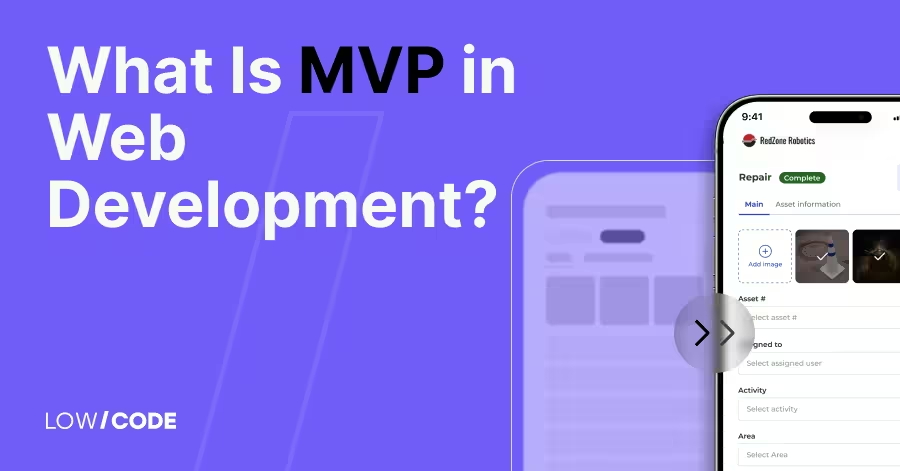
What Is an MVP in Web Development?
An MVP (Minimum Viable Product) in web development is a simple version of a web app or website that solves one main problem for users. It includes only the most important features to make it work. The goal is to launch quickly, test the idea, and get feedback from real users before building more.
You don’t need a full product to start. In fact, starting small is the smart way to build. A web MVP helps you learn what people actually want.
- What Counts as a Web MVP?
It can be a landing page that explains your idea, a contact form that collects emails, or a working web app with just one or two features. A feature-limited SaaS is also a common MVP, offering one key function instead of the full package. - MVP vs. Full Product
A full website or product has everything—full UI, all features, and a polished design. An MVP skips the extra features. It focuses on speed and learning. You build fast, test fast, and improve based on feedback.
In web development, using no-code tools like Bubble, Glide, and Webflow makes it easier to launch MVPs. You don’t need to write code to test your idea early.
Partner with LowCode Agency to Build Your Web MVP
At LowCode Agency, we've built over 330 successful web apps and MVPs using top no-code tools like Bubble, Glide, FlutterFlow, and Webflow. We help turn your idea into a market-ready web MVP that proves your concept and supports business growth.
Our team has worked with startups like RentFund, which reached a $3M valuation just four weeks after launch. We’ve also built large platforms used by thousands. We focus on finding the core features your web MVP truly needs, nothing extra.
What makes us different is our mix of tech skills and business strategy. With no-code, we deliver web MVPs up to 10x faster than traditional development. You can launch quickly, collect feedback, and improve without wasting time or money.
Your web MVP deserves a smart start, and we’re here to help.
Read more | LowCode Agency Case Studies
Benefits of Starting with an MVP in Web Development
Building a web MVP before diving into full-scale web development isn't just a smart strategy; it's essential for your web project's success. Here's why starting with an web MVP gives you a significant advantage:
- Validate your product idea early: Test your core assumptions with real users before investing heavily in development. You'll discover whether your target audience actually needs your solution and if they're willing to use it.
- Save time and cost: Focus your resources on essential features rather than building everything at once. This lean approach can reduce initial development costs by up to 70% while getting you to market faster.
- Get real feedback from users: Gather valuable insights from actual users interacting with your product. This feedback helps you understand what works, what doesn't, and what features users truly value.
- Reduce risk of failure: Minimize the chance of building something nobody wants by testing your concept early. MVPs help you identify potential issues before they become expensive problems.
- Attract investors and stakeholders: Demonstrate market traction with a working product rather than just presentations. Investors prefer seeing real user engagement and validated demand over theoretical projections.
- Pivot based on actual data: Make informed decisions about your product direction using real user behavior and feedback. This data-driven approach ensures you're building what your market actually needs, not what you assume they want.
Read more | Healthcare MVP guide
Key Features of a Successful Web MVP
Your web MVP needs specific features to effectively validate your concept and provide value to users. Focus on these essential elements to build an web MVP that delivers results:
- Fast-loading web pages: Ensure your web MVP loads quickly across all devices and internet connections. Slow-loading pages kill user engagement and skew your validation data, making it impossible to accurately assess user interest.
- Simple but clean UI/UX: Design an intuitive interface that guides users through your core functionality without confusion. Clean design doesn't mean boring; it means purposeful and focused on helping users accomplish their main goal.
- Responsive design: Build your web MVP to work seamlessly on desktop, tablet, and mobile devices. With over 50% of web traffic coming from mobile devices, responsive design isn't optional for modern web MVPs.
- Must-have core functionality only: Include only the features absolutely necessary to solve your users' primary problem. Resist the temptation to add "nice-to-have" features that complicate development and distract from your main value proposition.
- User signup/auth: Implement basic user registration and login functionality if your web MVP requires personalized experiences or data tracking. Keep the signup process simple with minimal required fields to reduce friction.
- Basic backend: Set up essential database operations including CRUD (create, read, update, delete) functionality and smooth data flow between your frontend and backend. This foundation supports your core features without unnecessary complexity.
- Analytics and feedback tools: Integrate basic analytics to track user behavior and feedback mechanisms to gather user insights. This data becomes crucial for making informed decisions about your next development phase and future iterations.
Read more | Mobile app MVP development guide
Step-by-Step Guide to Build an MVP for Web Development
Building a successful web MVP requires a structured approach that balances speed with strategic thinking. Follow this proven process to create a web MVP that validates your concept and sets the foundation for future growth.
1. Define the Core Problem Your Web MVP Solves
Start by clearly articulating the specific problem your web application addresses. Write a simple problem statement that explains what pain point you're solving and for whom. This isn't about listing features; it's about identifying the fundamental need your product fulfills.
Ask yourself: What is the one primary task users need to accomplish? Your web MVP should solve this single problem exceptionally well rather than attempting to address multiple issues mediocrely. This focused approach ensures your development efforts remain concentrated on what truly matters to your target audience.
2. Understand Your Web Users and Use Cases
Research your target users to understand how they currently solve the problem you're addressing. Create user personas that represent your primary audience, including their goals, frustrations, and preferred ways of interacting with web applications. This research shapes every design and functionality decision you'll make.
Map out the primary user journey from first visit to task completion. Identify the essential steps users must take to achieve their goal and eliminate any unnecessary complexity. This user-centric approach ensures your MVP delivers a smooth experience that encourages continued engagement.
3. Prioritize Features for Your Web App MVP
Use frameworks like MoSCoW (Must-have, Should-have, Could-have, Won't-have) to categorize potential features. Focus exclusively on "must-have" features that directly enable users to solve their core problem. Everything else can wait for future iterations.
Create a feature matrix that weighs user impact against development complexity. Prioritize high-impact, low-complexity features for your MVP while parking complex or nice-to-have features for later versions. This strategic prioritization keeps your MVP scope manageable and timeline realistic.
Read more | How to choose MVP features
4. Choose the Right Partner to Build Web MVP
Select a development approach that matches your timeline, budget, and technical requirements. No-code platforms like Bubble, Webflow, or Glide can significantly accelerate development while maintaining professional quality. Consider partnering with experienced agencies that specialize in rapid MVP development.
Evaluate potential partners based on their portfolio, expertise with your chosen technology stack, and understanding of MVP principles. The right partner will help you avoid feature creep while ensuring your MVP is built for scalability and future growth.
5. Build the First Version Fast and Functional
Focus on creating a working version that solves your core problem effectively. Resist the urge to perfect every detail; your goal is to launch a functional product that users can interact with and provide feedback on. Speed to market is more valuable than perfection at this stage.
Implement essential features with clean, simple interfaces that guide users toward their goal. Ensure basic functionality works reliably across different devices and browsers. A simple, working MVP is infinitely more valuable than a complex, unfinished product.
Read more | MVP case studies
6. Test the Web MVP with Real Users
Launch your MVP to a carefully selected group of target users who can provide meaningful feedback. Set up user testing sessions to observe how people interact with your product and identify areas of confusion or friction. Real user behavior often differs significantly from your assumptions.
Create multiple feedback channels, including surveys, interviews, and analytics tracking. Focus on understanding whether users can successfully complete their primary task and what obstacles they encounter. This feedback becomes the foundation for your next iteration.
7. Collect Metrics and Feedback for Iteration
Track key metrics that indicate whether your MVP is solving the intended problem. Monitor user engagement, task completion rates, and user retention alongside qualitative feedback about user experience. This data combination provides a complete picture of your MVP's performance.
Analyze feedback patterns to identify the most critical improvements and new features users actually want. Use this data to plan your next development phase, focusing on changes that will have the greatest impact on user satisfaction and business goals.
Read more | Bubble MVP app development
Web MVP Examples That Worked
These real-world examples demonstrate how effective web MVPs can validate concepts, attract users, and achieve remarkable business results. Each project started with a focused approach that solved one core problem exceptionally well.
1. ToyCycle
ToyCycle transformed the way children share and trade toys by creating a safe, parent-supervised marketplace that teaches sustainability through play. Built on FlutterFlow in just 9 weeks, this innovative platform solved the problem of toy waste while giving kids independence within secure boundaries.
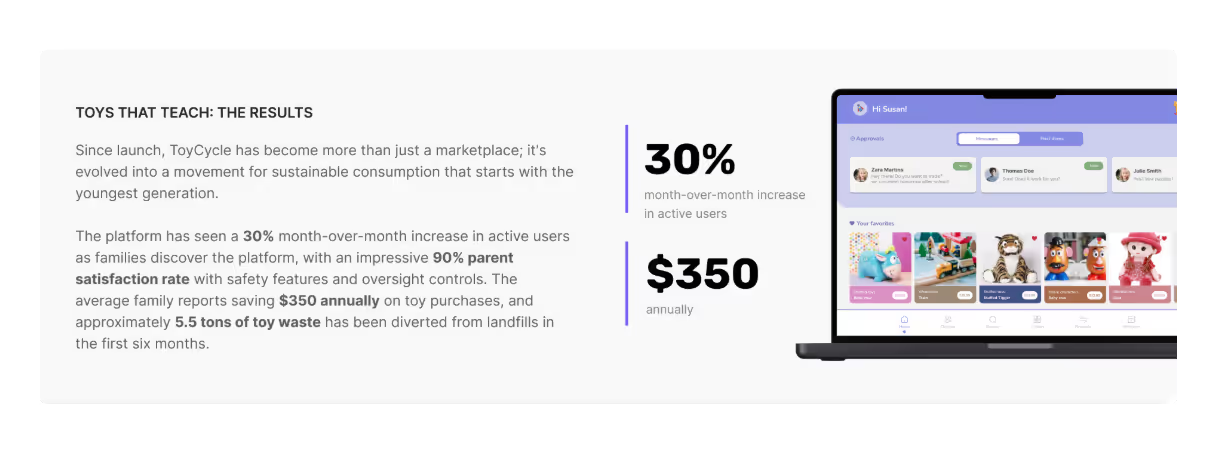
The MVP focused on essential features: verified school-based communities, parental oversight controls, and simple toy listing functionality. By prioritizing safety and simplicity, ToyCycle achieved a 90% parent satisfaction rate and 30% month-over-month user growth.
The platform successfully validated that parents wanted their children to learn responsible consumption while maintaining complete control over their safety.
2. TEN
TEN revolutionized event staffing by connecting event producers with qualified technicians through a specialized marketplace. Theodore Nelson identified that traditional networking methods were failing both sides of the industry, creating missed opportunities and inefficient hiring processes.
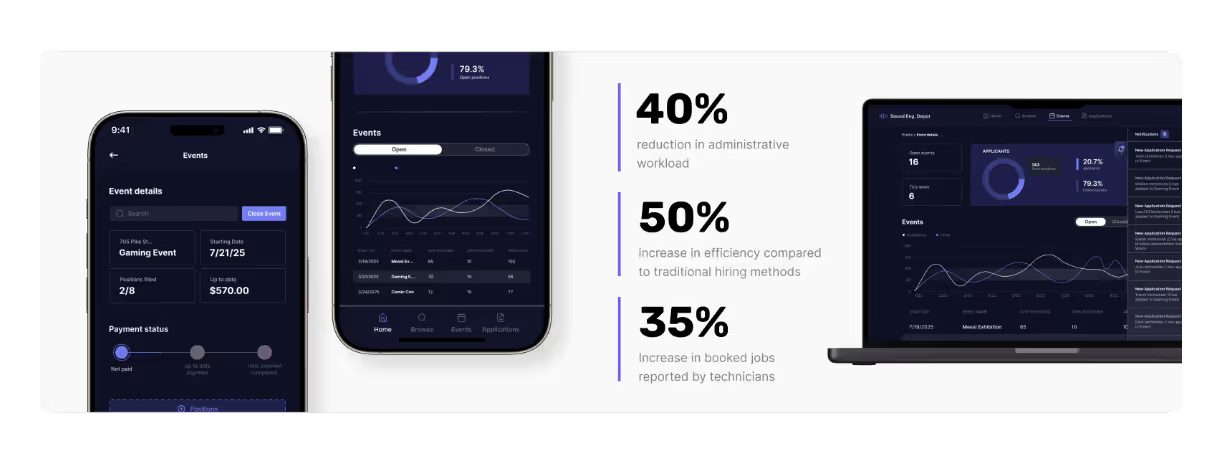
Built with Bubble in 8 weeks, the MVP focused on solving one core problem: matching technical talent with event opportunities quickly and securely. The platform included detailed requirement specification, direct communication tools, and integrated payment processing through Stripe Connect.
TEN achieved a 40% reduction in administrative workload and 50% increase in hiring efficiency, proving that digital solutions could transform traditional industries.
3. RentFund
RentFund tackled the outdated rental payment system by offering tenants 5% cash back on rent payments while automating verification for property managers. This innovative approach transformed the largest monthly payment most people make into a rewarding experience.
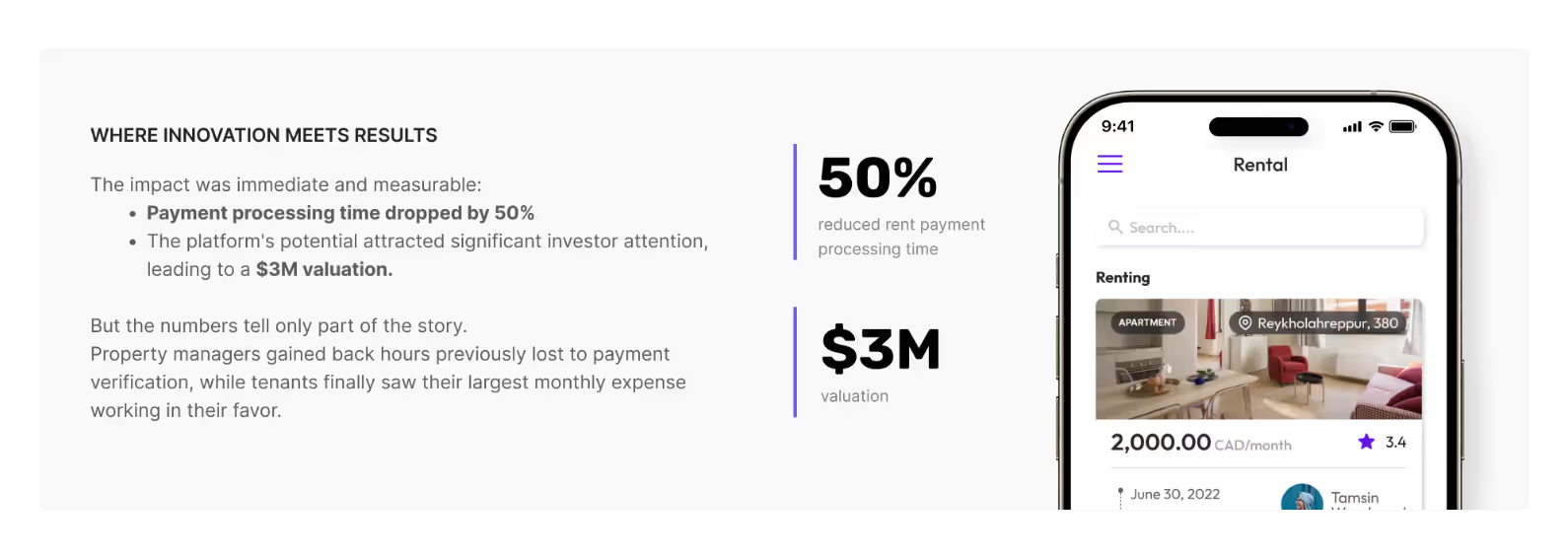
The 4-week Glide-based MVP focused on automated payment verification and reward distribution. By solving the dual problems of manual verification and unrewarded payments, RentFund achieved a 50% reduction in payment processing time and reached a $3M valuation. The platform validated that both tenants and property managers were ready for modernized rental payment solutions.
4. Language Keeper
Language Keeper addressed the critical problem of military professionals losing language skills between training sessions. Nibras Clapp recognized that expensive military language training was being wasted due to lack of consistent practice opportunities.
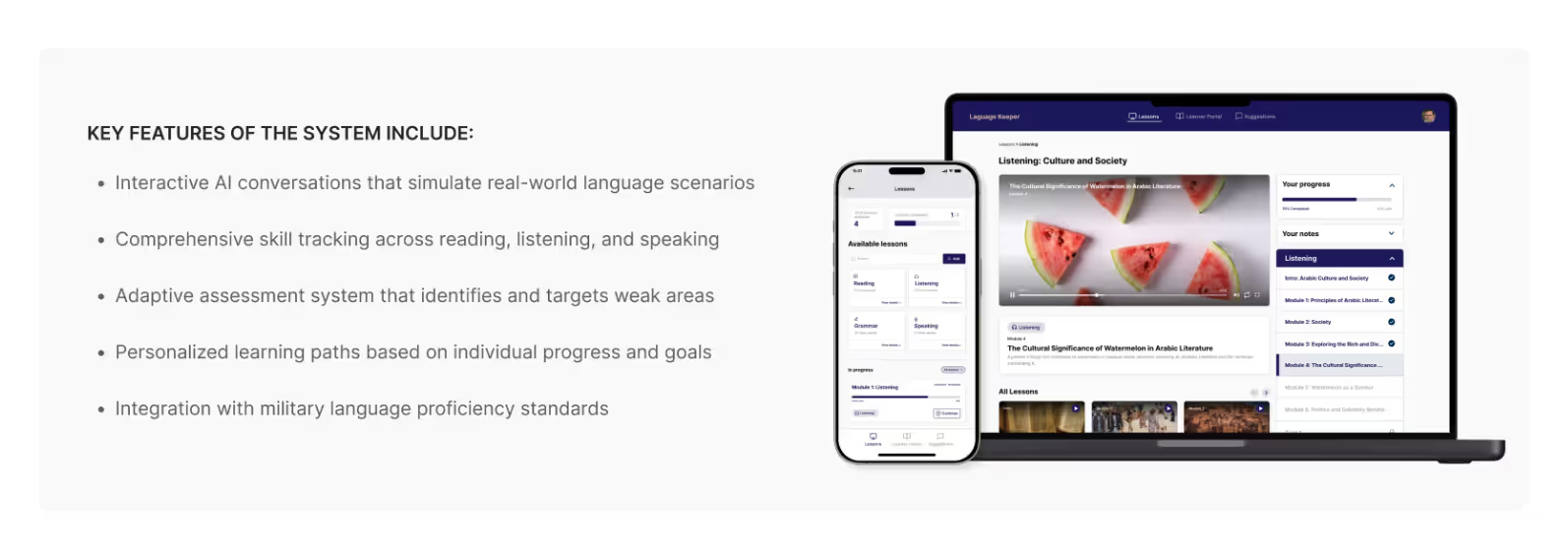
Built with Glide in 5 weeks, the MVP combined AI-powered personalized learning with military-specific requirements. The platform focused on maintaining language proficiency through adaptive practice sessions and progress tracking.
Language Keeper achieved a 70% increase in completed lessons and 90% user approval rating, proving that technology could solve complex educational challenges in specialized fields.
Common Pitfalls to Avoid When Building an MVP
Building a successful web MVP requires discipline and focus. Avoid these common mistakes that can derail your MVP's effectiveness and waste valuable time and resources:
- Adding too many features (feature creep): Resist the temptation to include "just one more feature" that seems essential. Feature creep is the number one reason MVPs fail to launch on time and within budget. Stick to your core functionality and remember that every additional feature multiplies complexity, development time, and potential failure points.
- Ignoring feedback from users: Collecting user feedback without acting on it defeats the entire purpose of building an MVP. Some founders become so attached to their original vision that they dismiss user insights that contradict their assumptions. Your users are telling you what they actually need; listen to them and adjust accordingly.
- Poor user experience or bad UI: Just because you're building an MVP doesn't mean you can neglect basic usability principles. Confusing navigation, cluttered interfaces, or broken functionality will drive users away before they can provide meaningful feedback. A simple, well-designed interface is far better than a complex, poorly executed one.
- Not setting clear success metrics: Without defined success criteria, you can't determine whether your MVP is working or failing. Establish specific, measurable goals before launch, such as user engagement rates, task completion percentages, or conversion metrics. These benchmarks guide your iteration decisions and help you recognize when it's time to pivot or scale.
Read more | MVP development challenges and mistakes
How Long Does It Take to Build an MVP?
Building a web MVP usually takes between 4 to 8 weeks. This timeline depends on your idea, how complex the app is, and the tool you use. A basic web MVP, like a landing page or form, can be built in 3- 4 weeks. If your project includes user logins, databases, or several screens, expect 6 to 8 weeks for full development and testing.
This range gives you enough time to build something useful without spending months in development. Using no-code tools like Bubble, Glide, or Webflow speeds up the process by avoiding complex coding tasks.
- Project Complexity
Simple apps take less time. Apps with many user types, features, or flows need more planning and work. - No-code Platform
No-code tools help you launch faster than traditional coding. Glide works best for simple apps, Bubble suits complex workflows, and Webflow is great for custom sites. - Team and Experience
A skilled no-code team like LowCode Agency knows how to cut delays and focus on core features. - Design Level
Clean, simple UI is quicker to build. Detailed or custom designs take extra time. - External Tools
Standard tools like Stripe or Airtable are quick to connect. Custom APIs can add 1 to 2 weeks.
With the right plan, your MVP can launch fast and ready for feedback.
Read more | SaaS MVP development guide
How Much Does an MVP Cost to Develop?
The cost to build a web MVP usually ranges from $5,000 to over $50,000. The final price depends on your approach, the platform you use, and how complex your app is.
- DIY - Some founders try to build MVPs themselves using no-code tools like Glide, Bubble, or Webflow. While this may look cheap, it often costs more in the long run. Learning these tools well takes hundreds of hours. Mistakes in app structure, database setup, or logic can lead to rebuilds later when you try to scale.
- Freelancer - Hiring a freelancer may cost between $5,000 and $20,000. This can be risky if they lack full knowledge of the platform. Poor app performance, limited support, and missing documentation can cause delays and added costs later.
At LowCode Agency, most MVPs start at $30,000. This includes strategy, design, performance setup, security, and post-launch support. You get a skilled team focused on your goals, building a reliable, scalable MVP.
- What Affects MVP Cost?
- Feature complexity
- No-code tool used (Glide, Bubble, Webflow)
- Custom design and integrations
- Team skill and support level
- Security and scalability needs
- Feature complexity
A strong MVP is an investment. Paying more up front often saves you time, stress, and money in the long run.
Read more | Startup MVP development guide
Final Thoughts on MVPs in Web Development
Building a web MVP is the smartest way to start your web app journey. It helps you focus on solving one real problem with the core features users need. This approach saves time, lowers cost, and lets you learn what works before scaling further.
A web MVP gives you real user feedback, which is more valuable than any market guess. You discover what users like, what they struggle with, and what features they actually use. These insights help you make better product decisions.
Instead of building everything at once, you test your idea in smaller steps. This reduces risk and keeps your team focused on what matters. Tools like Bubble, Glide, and Webflow make it easier to launch fast and improve quickly.
Ready to turn your web app idea into a market-tested web MVP? At LowCode Agency, we've helped founders like you build successful MVPs that validate concepts and drive growth.
Book a free discovery call today and discover how we can transform your vision into a validated, scalable web MVP that sets the foundation for your success.
Created on
July 18, 2025
. Last updated on
November 18, 2025
.

FAQs
What is MVP in web development?
How is a web MVP different from a prototype or PoC?
How do I choose the right features for a web MVP?
Can I build an MVP for the web without any coding skills?
What happens after launching a web MVP?
How long does it take to build an MVP in web development?





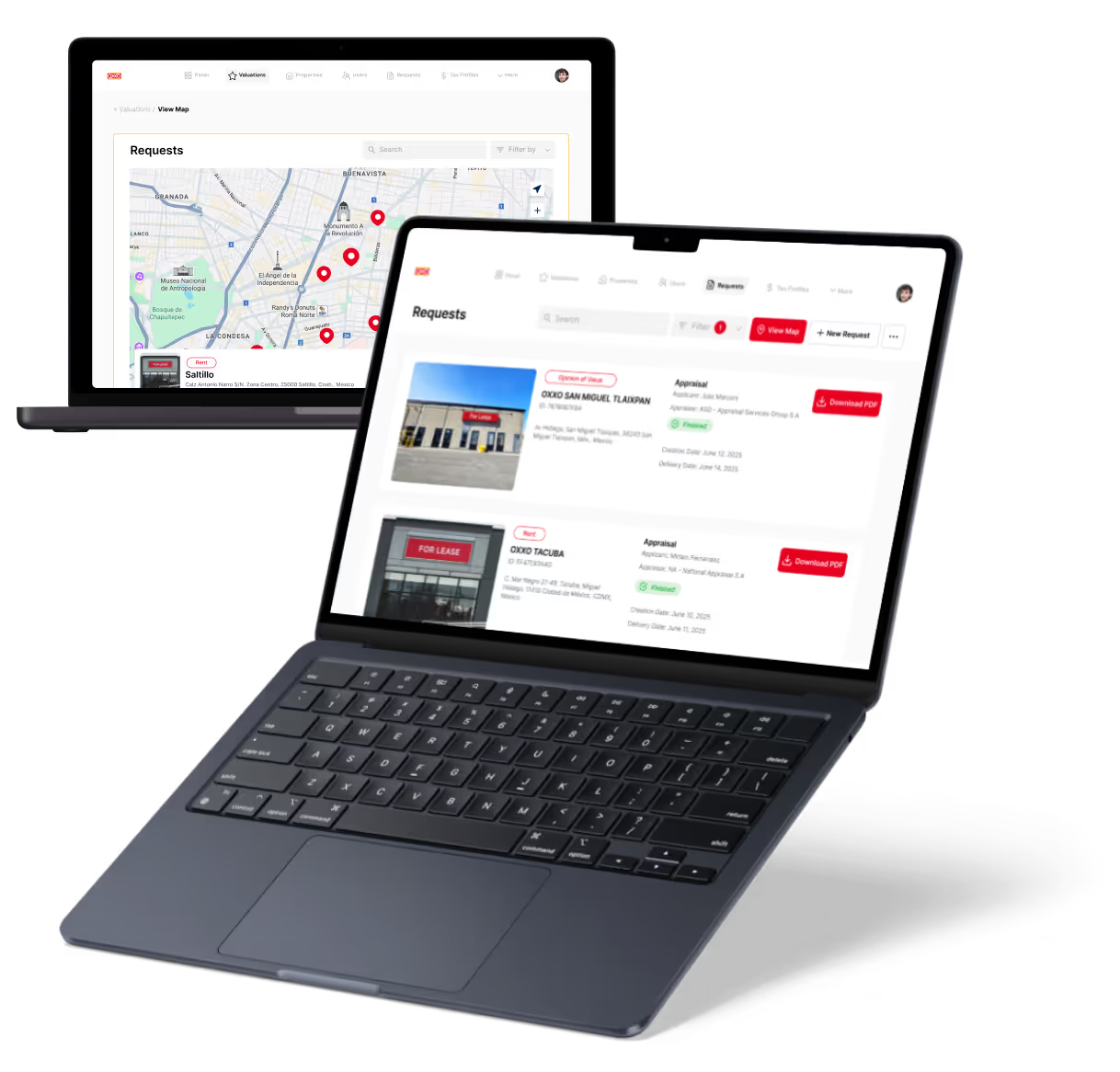

%20(Custom).avif)








